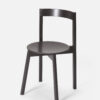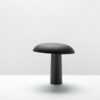Lee Ufan (b. 1936) is a South Korean artist and philosopher who has become internationally known for his diverse artistic output. His oeuvre includes painting, sculpture, and the publication of over seventeen books1. He was a founding member of the Japanese Mono-Ha movement and one of the central figures in the Korean Dansaekhwa movement.
Ufan is best known for his subtle, minimalist paintings and sculptures, which are characterized by the use of simple materials such as stone, wood, iron or glass. His works are characterized by a strong connection between nature and spirituality, conveying a deep philosophical message.
Lee Ufan was born on June 24, 1936, in rural Kyongnam, South Korea. He studied calligraphy, poetry, and painting. After moving to Japan in the 1950s, he gained international prominence in the late 1960s as a key figure in the Mono-ha movement (literally, ‘School of Things’) – Japan’s first significant contemporary art movement that rejected Western notions of art and representation.
Mono-ha and Dansaekhwa
Mono-ha emphasized material, perception, and interaction between space and matter. Not only Ufan’s philosophical writings but also his sculptures came to epitomize this movement at the time. One example is his 1968 site-specific sculptural floor work “Phenomenon and “Perception B”, in which a heavy stone falls onto a glass plate.1 He has grouped his later three-dimensional works under the title “Relatum,” combining stone, steel, and glass. The sculptures are intended to be seen as a network of relationships between the materials and the viewer.2
In the 1970s, when Lee Ufan became a professor at Tama Art University in Tokyo, he returned to painting. He soon became a central figure in the Korean group of artists called Dansaekhwa. This is an aesthetic movement that emerged in the 1970s during political unrest in South Korea. It embraces the beauty of simplicity through monochrome artworks that express stillness and peace amidst the turmoil. (If you want to learn more about this movement, I recommend the following article: An Exploration Of ‘Dansaekhwa’ – Korean Monochrome Art)
Exploration through painting
After visiting an exhibition by Barnett Newman at the Museum of Modern Art in 1971, Ufan found new inspiration in the calligraphy he had learned as a child. Ufan’s abstract works “From Point” and “From Line” date from this period. They depict the passing of time through the gradually fading colors.3
The viewer plays a crucial role in these works, as he/she activates the movements of the brushstrokes by looking at them and thus completes the artwork. Depending on the perspective, the artwork opens up different interpretations and invites self-exploration.4
Beginning in 1991, Lee Ufan found another form of expression with the series “Correspondance.” Here he applies one or two gray or colored brushstrokes to large white surfaces. For this, he uses a mixture of oil and crushed stone pigments. These minimalist works continue the play with perception and material in a painterly context, illustrating Ufan’s focus on the relationship between painted and unpainted space.
A lifetime dedication to art and spirituality
His tireless contribution has been recognized with the UNESCO Prize (2000) and the Praemium Imperiale (2001), among others. In 2010, the Lee Ufan Museum, designed by Tadao Ando, opened on the Japanese island of Naoshima. In 2011 the Guggenheim Museum in New York dedicated a solo exhibition to him.
His works create a meditative awareness and invite us as viewers to engage in subtle spirituality. They are characterized by a unique minimalist aesthetic and are informed by a deep appreciation for the natural world and the transience of all existence. In doing so, he not only challenges traditional notions of art but opens its horizons to a new dimension of thought and perception. With his focus on the intimate relationship between viewer, artwork, and space, Ufan’s practice underscores the dynamic interaction between material, perception, and environment that embodies the essence of human experience.
An interesting video on the spatial impact of his works, on the occasion of the first major retrospective in Tokyo in 2022, can be found here: https://youtu.be/FM3FYiIkdsw?si=BTdGKCrLhlkIF1KP
And here is an inspiring “Meet the Artist” video from Art Basel: https://youtu.be/gE7eqy2t8Uc?si=d0G5zyg6nkYInkbw
Further Reading /Resources
- https://www.pacegallery.com/artists/lee-ufan/
- https://www.guggenheim.org/teaching-materials/teaching-modern-and-contemporary-asian-art/lee-ufan-%EC%9D%B4%EC%9A%B0%ED%99%98
- https://leeufan.exhibit.jp/english/
- https://www.lvhart.co/journal/korean-dansaekhwa-masters-lee-ufan-park-seo-bo-lee-bae-and-ha-chong-hyun


